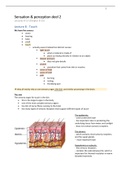1
Sensation & perception deel 2
Lectures 8-13 (Chapter 8-15)
Lecture 8 - Touch
We have five senses:
• vision
• hearing
• taste
• smell
• touch
o actually several related but distinct senses:
▪ light touch
• what a material is made of
• place our body precisely in relation to an object
▪ deeper pressure
• does not give details
▪ stretch
• sensation that come from skin or muscles
▪ sense of heat
▪ sense of cold
▪ pain
• burning
• itching
• throbbing pain
→ they all mainly rely on one sensory organ, the skin, and similar processing in the brain.
The skin
The sensory organ for touch is the skin
• this is the largest organ in the body
• one of the most complex sensory organs
• has lots of nerve fibres running to the brain
• has many types of sensory receptors that support different types of touch
The epidermis:
- outer protective layer
- has important roles in protecting the
underlying tissue from water and sunlight
- does not contain sensory receptors.
The dermis:
- which contains most sensory receptors,
and the sweat glands.
- most important layer
Hypodermis or subcutis.
- few sensory receptors
- contains the subcutaneous fat, which is
important for thermal insulation in warm
blooded mammals.
, 2
We have 7 sensory receptors (also named mechanoreceptors since they respond to mechanical
force)
Four types of these mechanoreceptors are:
1. the Meissner corpuscle
2. the Merkel cell complex
3. the Ruffini ending
4. the Pacinian corpuscle
These mechanoreceptors all respond quite differently.
Highlighting the : The Pacinian corpuscle
• its deep located (hypodermis)
• It is the only mechanoreceptor in the hypodermis (subcutis).
As a result, the forces on the receptor could come from a
large area of skin:
→ so it has a large receptive field.
• It’s made up of lots of layers
o In the middle of these layers is a nerve ending in a little capsule.
o When this capsule is deformed by a force, this forces open Na+ ion channels in the
nerve ending, depolarising the membrane (-70 millivolts -> -30 millivolts).
→This is an extremely simple mechanism to depolarise the neuron’s membrane. This
causes an action potential, and because this neuron is wrapped in myelin, the action
potential jumps over the myelinated nodes to allow very fast nerve conduction.
▪ There are a few important things to note about this depolarisation.
▪ First, the pressure must be above a certain strength to trigger an action
potential (pressure B).
▪ Second, the receptor’s membrane potent rapidly returns to its polarised
state when the pressure is left on. So this
receptor will rapidly adapt to a new pressure
state.
▪ Third, if the pressure is greater (pressure C)
the membrane potential remains above the
action potential trigger threshold for longer,
so makes more action potentials.
▪ So this receptor is only sensitive to CHANGES
in pressure, and the size of the change is
encoded by the number of action potentials.
So, we have different touch receptors in the skin. They all have some extended shape, where
pressure on the skin leads to a change in the shape of the receptor.
This change in the receptors shape leads to some change in membrane potential, with different
mechanisms (not important for now). Why do we need four (or more) different receptors for touch?
, 3
Differences between these receptors
1. The first important difference is their adaptation rate: does the receptor signal pressure, or
CHANGES in pressure?
• Pacinian corpuscle and The Meissner corpuscle → high
adaptation rate (signals changes and stops responding
to constant pressure over time as well as space)
• Merkel cell complex and Ruffini → slow adaptation
rate (keep responding if pressure stays, decreases
response only slowly
2. The second important difference is their receptive field size: does the receptor respond to
touch over a large area or a small area?
• Pacinian corpuscles and Ruffini endings are deep in the skin, so sensitive to
pressure over a large area.
• Meissner corpuscles and Merkel cell complexes are much closer to the surface, so
only respond to pressure in a small, local area, a small receptive field
Meissner corpuscles Merkel cell Ruffini endings Pacinian corpuscles
complexes
Position in skin Lie near surface Lie near surface Lie deeper Lie deeper
Size of receptive field Small RF Small RF Larger RF Larger RF
Adaptation rate Fast adaptation rate Slow adaptation Slow adaptation Fast adaptation rate
(Adapt to changes rate rate (Adapt to changes
rapidly, (adapt to changes (adapt to changes rapidly,
Signal changes in slowly) slowly) Signal changes in
pressure only) pressure only)
Touch offset Does respond Does not respond Does not respond Does respond strongly
strongly to touch strongly to touch strongly to touch to touch offset
offset offset offset
→ these receptors let us feel a large range of different stimuli, which each produce different and
easily distinguished touch sensations
These density of these different receptors changes across the body.
• Hands, face and feet:
• many mechanoreceptors with small receptive fields, so we can make fine distinctions
between stimuli.
o This is normally measured by the two point detection threshold: how far
apart must two points lie on the skin for us to reliably distinguish
between one point and two. When this threshold is low, that means
points can be distinguished close together, and the skin is sensitive here.
• The rest of the body
o The two point detection threshold is higher and we are less sensitive to fine
touch details






